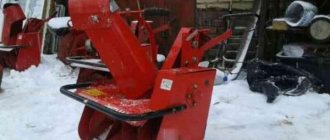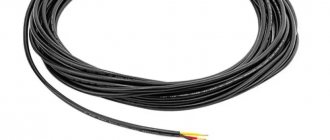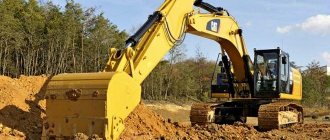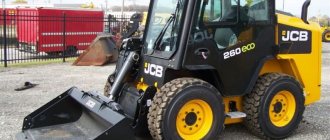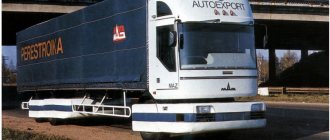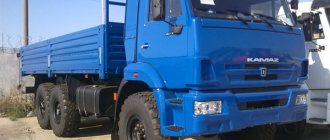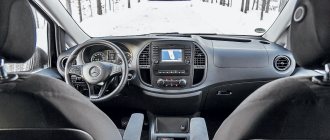Category: Auto news.
Winter driving is difficult for any driver, and when the driver has 40 tons of cargo behind him, it is doubly difficult.
Factors that make it difficult for road trains to move on slippery roads:
- the route runs through narrow and winding sections, there are slopes on the road
- the road train is long, wide, heavy.
The large dimensions of the vehicle force the driver to often press to the side of the road to let oncoming cars pass. This situation in itself is already a risk of the trailer skidding.
Another emergency factor is the movement of a road train on turns and steep slopes. The driver needs to constantly monitor the speed and choose a position on the road so as not to hit other road users with the trailer. And also - constantly monitor and take into account the adhesion of your vehicle to the road on each section of it.
In such conditions, the driver can only count on a reliable braking system and high-quality tires as assistants.
Features of driving a truck in winter
Driving a truck in winter has a number of features that must be taken into account. Otherwise, unforeseen situations may arise, including road accidents.
In winter, it is strictly forbidden to make sudden movements with the steering wheel.
Braking, climbing a hill, and stopping should be done taking into account all external factors. Let's look at how to properly drive a truck in winter during snowfall and ice.
You can get acquainted with the important nuances of loading a truck in winter and driving features, which an experienced truck driver talks about, here:
Speed
In winter, the driving speed is selected taking into account the situation on the road. On a flat, empty road you can drive a little faster. In heavy traffic, you should take into account the condition of the road surface and calculate the braking distance in advance.
It is not recommended to drive a truck in icy conditions at speeds exceeding the norm - it is dangerous.
Adequate speed is the key to safety
Descent-ascent
Lowering and lifting a truck on a winter road is not an easy process. A large number of drivers are afraid of this maneuver or do it incorrectly.
The descent is more difficult than it seems. It is associated with the majority of all winter road accidents.
The engine should brake. If you need to perform a descent and then an ascent, then try to do it in one gear.
As you climb up, gain acceleration and select a gear. Avoid slipping and stalling. It is often impossible to drive downhill when there is ice on the road.
Scania truck on the rise
Lighting and signals
The rules for giving signals and turning on lighting are standard. There is no difference in winter and summer. There are conventional signs that drivers use to inform each other about the condition of the road, vehicle, possible skids, but nothing more.
Headlights are always on in poor visibility conditions
Ice
Driving a truck in icy conditions is difficult and dangerous. More than one driver has suffered from failure to follow simple rules.
While driving on ice you must not:
- turn the steering wheel sharply;
- change gear when braking or turning.
If the vehicle skids , immediately change the braking method: release the brake pedal, reduce the engine speed. Turn the steering wheel in the direction you plan to move. Otherwise, when the gas is applied, the car may be pulled towards the turned-out wheels - and an accident cannot be avoided.
Ice is especially dangerous in winter
Attention to other drivers
The driver must exercise extreme caution at all times and be prepared for an unforeseen situation. Sometimes it seems that you are in control, but sometimes something goes wrong for another participant in the traffic, and his car becomes uncontrollable - it spins and carries.
Truck on a snowy road
Sometimes, for example, a Gazelle driver, while overtaking, may drive out behind an oncoming truck - there is almost no time to react.
If you see that the car in front of you is trying to overtake, slow down.
Monitor the situation on the road. Sometimes drivers of other vehicles are simply inadequate.
Traction and grip
In winter, many cars lose traction. The reason for this is the slippery road.
When there is slight frost, a thin layer of water forms on the ice, leading to skidding. At very low temperatures, the grip on the road surface is much better. The car behaves calmly and confidently.
Stop
Not all drivers can brake their truck correctly in winter. The stop must be planned in advance.
Before performing the maneuver, you must take the rightmost lane, turn on the turn signal and begin a planned reduction in speed without sudden movements of the steering wheel. You can reduce the speed either by using the brake pedal or changing gears.
Pressing the brakes for a long time causes the drums to overheat. In emergency cases, you can use the handbrake.
Braking into trees
Where is the truth really and is it necessary to warm up the machine in winter? Experts answer questions.
The main thing is that warming up an automatic car with a torque converter type gearbox is a necessary procedure!
This is due to its design. You need to understand that transmission oil in an automatic transmission functions as a working fluid both for lubrication and cooling of parts, and in order to transmit torque to the shafts and clutch connections. Moreover, to successfully warm up an automatic car in winter, two conditions must be met. Firstly, all channels of the valve body must be filled with clean ATF fluid. Used oil always contains microparticles that impede its circulation and reduce the efficiency of performing its functions.
Secondly, the system must have the required level of oil pressure. If these rules are not followed, shocks and jolts will be felt when changing gears, which will lead to rapid wear of the clutches. Due to low pressure, the clutches will close with great delay, the friction layer will quickly be erased, and suspensions will be transferred to the valve body channels with all the ensuing negative consequences.
Anticipating a barrage of questions, you can immediately answer those who are still against warming up.
Why warm up if:
· ATF fluid is actually oil and does not freeze?
Yes, it does not freeze, but in the cold it thickens greatly, especially in cases of significant mileage. And ATF crystallization processes are a direct path to malfunction.
· Does automatic transmission parts warm up from the power unit?
Right. Heat exchange actually takes place. But we must take into account the fact that in the cold this process will take a very long time, which will lead to unnecessary waste of fuel.
· Are automatic transmission oil seals able to withstand high pressure?
That's right. Only under “cold” start conditions will not only the oil seals, but also other automatic transmission parts be subjected to high loads. And, as you know, overloading any part is not good for it.
What to do if it breaks down in severe frost
In summer, a car breakdown is not so bad. But in winter everything is more complicated. You should understand that repairing a car on your own, waiting for a tow truck or technical assistance can last quite a long time. If it is very cold outside, you can freeze.
When going on a flight in winter, you should take everything that could be useful in case of a breakdown: warm clothes, a rug, a thermos, etc. It would be better if all this would not come in handy, but it should be.
Hot tea in winter in KamAZ
What to do with a frozen battery? How to properly defrost and charge a frozen battery?
The first step is to ensure the continued suitability of the battery by inspecting the case for cracks and breaks (very often the ice inside breaks the thin plastic walls of the case). After inspection, the battery should be removed from the vehicle and placed in a warm room.
The most important thing is not to charge the battery while there is ice in it to avoid a short circuit.
The battery should be completely frozen and the electrolyte temperature should be close to room temperature. After defrosting, we once again inspect whether there are any leaks in the body (the swollen walls should return to their original form). If you observe some kind of liquid on the battery case, you should determine its origin using a litmus indicator. If the paper turns red, then you are dealing with acid, which is the main component of the electrolyte and can leak through cracks in the battery case. Intuitively, you should be aware of the fact that you can burn yourself with acid.
Sometimes it happens that small cracks in the battery case are ignored, mistaking the slightly damp walls for water condensation. As a result, after the battery is defrosted, charged and ready for use, it will flow slowly but surely. There is, of course, the option of sealing the battery case (to do this, drain all the contents and take the soldering iron in your hands), but the probability of a positive outcome of this operation is approximately one in ten. Because you can only seal a crack that is located on the side (not at the bottom or on the corner) and that extends only to one can.
Next, we proceed to charging, remembering that the charge current is defined as ten percent of the nominal battery capacity in ampere/hours. In this case, the charging process lasts about ten hours. But this is a “handicraft method”. Ideally, the battery is charged with different currents; initially, you need to break through the sulfation on the battery plates with a pulsed high current, then give the main charge a constant low current and bring the battery to an intermittent low current to completely restore the plates. The main thing is that we must charge the battery completely (preferably with an automatic charger), after which we must check the transparency and density of the electrolyte. Cloudy electrolyte indicates that the plates have crumbled. If everything is in order, then you can safely install the battery and drive on.
Are spikes needed?
Tires are an integral part of successful driving. To increase road stability, special winter surfaces with spikes . They simplify vehicle control and increase road traction. It must be remembered that the wear process is rapid, so you need to constantly monitor the technical condition of the tires.
Trucks with studded tires are often called winter trucks. According to the majority, spikes (winter roads) are needed. Of course, you can do without them, but it’s easier with them.
Truck with studded tires
Driving in winter
The golden rule when driving on slippery road surfaces is to do everything as smoothly and carefully as possible: this is good advice for driving in any conditions, but it becomes vitally important when the road is snowy or icy. You must always be aware of the danger of skidding because the grip of your car's tires is significantly reduced in winter.
A skid is invariably caused by a sudden movement of the steering wheel or too rough use of the brake or accelerator pedals.
Haste is good in other situations, in winter - remember this! – it is important to drive the car smoothly and clearly! However, depending on the technical equipment of your car (presence of ABS, dynamic stabilization and other auxiliary technologies), as well as on the type of surface and weather conditions, a smooth press on the brake pedal is not always acceptable
Modern cars, with the help of electronic systems, do a good job of coping with emergency situations, however, it is important to remember that the main control element is still the driver
However, depending on the technical equipment of your car (presence of ABS, dynamic stabilization and other auxiliary technologies), as well as on the type of surface and weather conditions, a smooth press on the brake pedal is not always acceptable
Modern cars, with the help of electronic systems, do a good job of coping with emergency situations, however, it is important to remember that the main control element is still the driver
A clear example of braking with the anti-lock braking system on or off: How to stop a car in the snow with ABS
Here is another clear example of a common phenomenon - skidding. On a slippery surface it is more likely, and therefore you need to know not only the theory, but also study practice. The first, the theory, is as follows:
Video taken from the YouTube channel “Online Driving School Autoinline”
Secondly, it is best to gain practice with an experienced instructor at an extreme driving school.
Main causes of road accidents
Not everyone can drive a truck correctly in winter when there is ice. The result is an increased number of road accidents.
Let's look at the main reasons:
- Out-of-season tires. There is no point in being lazy or saving money here. The payment may be too expensive.
- Ice. The car often behaves unpredictably.
- Snow jams.
- Very coldy. “Winter” fuel will save you from “waxing” the fuel system. The autonomous heater warms up the engine very quickly. Therefore, it is advisable to install it on a truck.
- Violation of traffic rules (traffic rules).
- Bad visibility. In fog it is better to drive with low beam headlights. It would be nice to install fog lights.
Accident on a snowy road
Refuel only with proven fuel
In winter, refueling your car requires special attention. If you fill the tank with low-quality fuel, you can easily end up in the middle of the road, and it’s good if it doesn’t turn out to be a deserted highway.
In 2022, the Federation of Car Owners of Russia, just during the off-season, checked absolutely all gas stations in Krasnoyarsk and its suburbs, taking diesel fuel for testing. It turned out that not every gas station complies with technical regulations, and even if it has a quality certificate, it purchases fuel not from large suppliers, but from some samovars. If you refuel with such fuel in cold weather, the entire fuel system of the car will freeze,” says Yegor Frolov.
In order to be confident in the quality of fuel, experts recommend choosing gas stations of large chains that value their reputation, sell fuel from their own refineries and have a strict quality control system from the plant to the gas tank. In our region, this is, for example, the Gazpromneft network.
“At gas stations of the Gazprom Neft network, diesel fuel is sold that corresponds to the season and temperature. One of the important performance characteristics of diesel fuel is the filterability limit temperature, which indicates the lowest temperature at which the fuel is able to pass through the filter. In winter, at the gas stations of our network, depending on the ambient temperature, diesel fuel is sold with the actual value of this parameter from minus 22 to minus 45 degrees,” comments Yulian Khadanovich, head of the Gazpromneft gas station network in the Krasnoyarsk Territory. “Switching to winter diesel at gas stations our network is scheduled for early November.”
Experts add that the so-called depressant-dispersant additives, which are sold in car dealerships and supposedly allow you to “revive” frozen diesel fuel, are not always effective and are also unsafe for the car’s fuel system.
Also, in the cold season and off-season, you should pay attention to the fullness of the fuel tank - this will eliminate excess moisture condensation in the tank. “If the tank is almost empty, for example, 50 liters of fuel out of 60 have been consumed, the free space is filled with fuel vapor and atmospheric air, the natural moisture of which, when cooled, turns into 0.6 grams of water
When the tank cools, water will condense on the walls and flow to the bottom. For three spent tanks of fuel, this will amount to about 2 milliliters of water, the presence of which will negatively affect the performance of the fuel system,” say experts from the Siberian State Automobile and Highway University
“If the tank is almost empty, for example, 50 liters of fuel out of 60 have been consumed, the free space is filled with fuel vapor and atmospheric air, the natural moisture from which, when cooled, turns into 0.6 grams of water. When the tank cools, water will condense on the walls and flow to the bottom. For three spent tanks of fuel, this will amount to about 2 milliliters of water, the presence of which will negatively affect the performance of the fuel system,” say experts from the Siberian State Automobile and Highway University.
Photo: Sergey Ivanov
Trucker tips
Correct driving in difficult winter conditions requires the driver to know the unspoken rules. Experienced truckers shared some of them:
- “Be relaxed. If your car gets into a difficult traffic situation, do not panic. Excessive nerves can prevent you from making the right decision.”
- “Slow down. If the weather is unfavorable, move more slowly than usual. No one knows how to brake quickly, especially on ice.”
- "Be careful. The maneuvers performed must be judicious and controlled. Remember: sudden acceleration or braking can cause skidding, folding, etc.”
- “Keep the correct lighting conditions. In cloudy weather, turn on low beam headlights. This will allow you to see your car from afar.”
- “Be careful on slippery roads. The truck is difficult to control on ice. If you see a difficult section of the road, reduce your speed.”
- “Don’t stop in heavy snow or thick fog. If you see practically nothing, do not rush to stop. First, choose a safe and proper place. If you stop on the road, over time you may be covered with snow, the car will become invisible and cause an accident.”
- “If visibility deteriorates in winter, you need to leave the highway and wait out the bad weather. Relax in a hotel, cafe or car. Life is more valuable."
- “Talk to people you know. Listen to the advice of experienced drivers, watch videos of truck drivers.”
Useful tips for new truck drivers from an experienced colleague can be found here:
Remember: you alone are responsible for all the maneuvers your vehicle performs. Therefore, driving a truck must be confident and professional. Improve your skills and be careful.
Riding in winter: Turning is a major concern unless you are an experienced rider.
Winter is a joy for athletes. Skidding is a familiar and useful phenomenon for them, and practicing it on ice is much easier, because much less speed is needed to achieve the desired effect. For the ordinary citizen, it’s the opposite. In winter, every driver should strive to avoid becoming a reluctant athlete. To do this, you need to brake in advance and switch to a lower gear so that you can drive smoothly in an arc, without braking, with a little gas.
If you approach a turn too quickly, the car simply stops fitting into it. This does not depend at all on the type of drive - in this case, any car is carried outside, which is accompanied by an unpleasant squeaking of the wheels. It is by the creaking that inexperienced drivers usually understand that not everything is going smoothly. When a car doesn't want to turn, the natural reaction is to tighten the steering wheel. It turns out even worse: in such a situation, it is even more difficult for the front wheels to regain traction. It’s unlikely that anyone will be able to do this without training, but in principle the correct way is to, firstly, release the gas, and secondly, slightly reduce the steering angle. When you release the gas, the front wheels are loaded (the car dives), and since they are already at a smaller angle to the road, they are more likely to catch on it and start spinning. Then you can turn the steering wheel again in the direction of rotation. And everything else that concerns turning is already from the near-sporting sphere, where it is better for an ordinary, not at all trained car enthusiast to meddle.
After all, with athletes it’s the other way around – they themselves cause skidding. On rear-wheel drive, this requires adding gas after turning the steering wheel. The rear axle slides, and the car begins to turn its nose where it needs to be. But the problem is that as soon as the skid begins, you must immediately turn the steering wheel in the same direction as the rear of the car is moving in order to get it out of it. And this, alas, is more difficult than causing a skid. On front-wheel drive, adding gas will not cause any skidding. At low speeds, the handbrake can help create a skid on the rear axle - turn the steering wheel and pull the lever. The rear wheels are blocked, the rear turns around. Do not do this at high speed - the handbrake may be damaged. Here you must first of all let off the gas - the car nods, the front wheels are loaded and become less prone to slipping. After this, if you turn the steering wheel, a slight skid of the rear axle may begin, which helps point the nose of the car in the desired direction. To make the skid stronger, you need to press the brake a little. But only very slightly, just touch the brakes, otherwise all the wheels will lock and the car will simply slide outward. And when pressed very lightly, due to the redistribution of mass forward (peck), the lightweight rear axle begins to slide. Once again repeating that all this is not for ordinary drivers, let us mention the third way to cause the rear axle to skid on a front-wheel drive vehicle. When approaching a turn, you must first turn the steering wheel in the opposite direction. And only after the car obeys, turn in the direction of the turn. With this preliminary turn, you seem to rock the car, and the rocking leads to skidding of the rear axle. But the problem is that every skid requires a way out of it - and this is more difficult than causing it. To succeed, you need to repeat the same exercise many times. Our learning experience shows that the more you repeat, the better you understand how difficult it really is. And such a feeling is already a good sign, consider that you have overcome the first stage.
What to do if your car starts to skid
Briefly switching on neutral helps to combat skidding of a car on a slippery road surface. The opinion of some drivers that such an action can damage the automatic transmission is erroneous. Thanks to the instant, clear and accurate engagement of neutral, the car is stabilized, which leads to the cessation of skidding.
The same should be done when taking turns at low speed if they are located on a slope. On such descents, the car may become uncontrollable using the brakes and continue to move in the wrong direction. By briefly moving the box to neutral, it is possible to align the wheels and stabilize the position of the car.
We hope that the recommendations and suggestions we offer in this article will help owners of cars equipped with automatic transmissions drive in the winter without any troubles or undesirable situations.
Braking
On slippery sections of the road, it is necessary to use the engine braking method or combine it with a pulsed press on the brake pedal. Sharp and short-term, 2-3 times, pedal presses should be repeated until the required speed reduction or complete stop of the machine. This method is very effective to avoid wheel locking. There are also some other very important tips:
- When braking, there are moments when the engine is about to stall. To get rid of this problem, reduce the pressure on the brake pedal, but do not release it completely.
- Engine braking must be done in the gear that is currently engaged. However, on a descent, it is best to switch to a lower one, and to the one on which, in your opinion, it is possible to climb this slope.
- Avoid using the parking brake. The desire to make a daring maneuver or turn in a narrow place can lead to a loss of control, and then you will definitely get into trouble.
- For a sharper stop, use the “press-release-press-release” method of spring-pressing the brake pedal. At the same time, do not release the brake pedal all the way, just loosen the pressure. This method must be combined with trajectory alignment with the steering wheel. If you don’t do this, skidding and turning around your axis are inevitable.
- To reduce speed, you should try to choose dry areas with bare asphalt. If this is not possible, smoothly roll off to the side of the road, making sure that its condition allows you to do this, and then brake on it. The fact is that the roadside is usually covered with gravel or has an earthen base, and the ice film on it is much easier to break with wheels.
- Remember that outside populated areas, at the approaches to bridges and public transport stops, there are areas covered with ice.
Driving in icy conditions is also different in that the distance must be noticeably increased, since the braking distance, compared to dry summer weather, increases up to 8 times. For example, at a driving speed of 40 km/h, the distance should be about 80 m.
The video shows how to safely brake on ice
It is important to brake correctly
In icy conditions and slushy snow, the braking distance of a car increases, and the wheels often lock, after which the car goes into an uncontrolled slide. Even with high-quality winter studded tires, it is often difficult to brake on ice, especially if such braking is carried out incorrectly by the driver.
It is recommended to brake impulsively on a slippery road. It is necessary to briefly press the brake 4-5 times, which will simultaneously reduce the speed, while preventing the wheels from locking. With this correct braking, ABS, if the car has such a system, will not activate, but the car will effectively slow down.
Why should you not allow the anti-lock braking system to engage? The fact is that the braking distance when ABS is activated on a slippery road increases significantly. Indeed, the car does not go into an uncontrolled slide, but the braking distance increases significantly. Whereas, by pressing the brake pedal several times briefly, you can prevent sliding, but at the same time the efficiency of slowing the car significantly increases.
A common mistake made by beginners when braking in the winter is to suddenly press the gas pedal. This leads to complete blocking of the wheels, the car begins to roll on a slippery road, practically without slowing down, which leads to traffic accidents.
How does disabling the ESP system work on different cars?
All cars, as we know, are created differently. The algorithm of the ESP system is also different. Especially when disconnected. For example, in some cars, pressing the ESP OFF button once only turns off the ABS system first. This is how, in particular, disabling ESP works in the Hyundai Creta crossover. If you then press the button again within a few seconds, the stabilization system will turn off completely.
But on many cars (for example, regular Mercedes cars), the ESP system cannot be completely disabled. This is what the automaker intended, taking care of the safety of drivers. On many modern Mercedes you won't even find a separate ESP OFF button to deactivate the stability control system. To do this, for example, you need to go into the settings menu for various functions and turn off the system.
And then, as we have already said, you will not turn it off completely. The system will still, although inactive, interfere with driving.
No, you will, of course, feel more freedom, but nevertheless, in emergency situations, electronics will definitely intervene. Moreover, you will feel it most at high speeds. By the way, in many cars the ESP system is deactivated only when the car is moving at speeds up to 50 km/h. If the speed is exceeded, the system is automatically fully switched on again.
Also, in almost all cars, if you turn off ESP, you shouldn't expect it to be deactivated after you turn off the engine and start it again. In most cases, the stabilization system will automatically turn on again when the engine is started again.
Tricky braking
Pros and cons of working as a female truck driver
Everyone knows that it is important to slow down on a slippery road in advance. But not everyone does it correctly.
Emergency braking should be avoided in winter. If you hold down the pedal like in the summer, you will cause slipping.
- In a situation where you need to quickly slow down, for example, when exiting the Moscow Ring Road, the usual pressing of the pedal will only lead to ABS operation - which is unpleasant.
- If you try to slow down by pressing the pedal with your foot, at the approach to a pedestrian crossing or a “sleeping policeman,” you can go into a skid - such sections of the road are always rolled to a mirror shine.
An adequate way out of the situation is to brake with the engine, lowering the gears on the manual transmission and smoothly releasing the clutch. This will help to brake effectively while the driver maintains full control.
When approaching a traffic light, it is better to brake with short, intermittent presses on the pedal, simulating the operation of ABS. This way the wheels will slow down at the same time - there will be no slipping.
How to drive properly in deep snow?
The most important advice, especially for car owners, is not to drive in deep snow. No matter how correctly you drive your car, there is still a danger of getting completely stuck in the snow, and you can only pull the car out with a cable. And yet, if you need to overcome an obstacle with such deep snow, then it is best to reduce the tire pressure to one and a half atmospheres in advance. Winter tires with such low pressure have better chain properties, which will allow you to overcome slush or deep snow. Just remember to inflate the tires to standard values in the future.
12.12.2017
If you have rear wheel drive, load the rear axle
Rear-wheel drive in winter is an art. One of the most insidious phenomena is slipping of the rear axle. To minimize drive wheel slip, load something heavy in the trunk. This could be some additional tool (relevant for not very new cars) or just a bag of sand, heavy enough to reduce slipping; 10, 15, 20 kilograms will be enough to load. Although, again, everything is quite individual, depending on what kind of car, its technical condition and other conditions.
The main thing is to secure it in the trunk, otherwise a 15-kilogram bag, in which case it can cause very serious damage to the car interior and passengers.
Choosing the right speed
Cargo transportation 5 tons
It is the correct choice of speed limit that will be the key to safe driving in snowy and icy conditions. If in the summer you can easily drive 50-60 or even 70 km/h on dry, tenacious asphalt in the city, then in winter on a slippery surface, choosing this speed limit can lead to a sudden skid and an accident. Do not allow yourself to make dangerous and sudden maneuvers on ice and slush.
The optimal speed limit in winter on such a slippery road is 40 km/h. Moreover, you should accelerate as smoothly as possible. Avoid wheel slipping when accelerating and changing gears. Remember that even at minimum speed, any sudden acceleration will lead to wheel slip and skidding.
Smooth ice surface...
Let's say your car is slipping on an icy horizontal surface.
Try starting in second gear. When you start in second gear, the torque applied to the wheels decreases. Therefore, wheel slip is reduced. This technique is easy to do on a manual transmission; as for automatic transmissions, some transmissions have the ability to enable a special mode - ice.
And lucky are those drivers whose cars are equipped with a traction control system, which itself detects slipping and distributes the load on the wheels in such a way as to ensure maximum traction.
Lateral spacing
The braking distance on ice increases - the distance must also be increased so as not to hit your neighbor in the rear bumper. Again, many people know about this, but they forget about the situation on the side.
When driving in traffic, it is important to adhere to a checkerboard pattern
- When your bumper is in the area of the rear axle of the car in front, its driver does not see you - you are in the “blind” zone. Add to this poorly cleaned and foggy windows and mirrors in winter - we get a real risk of an accident when changing lanes.
- There is another reason - in winter all drivers should be pessimists. If a neighboring car skids, you should have enough time to react.
To avoid getting into an accident where you are hit by a car that has lost control, keep your distance, including the side distance.
